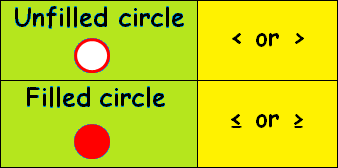SOLVE INEQUALITIES
An open sentence that contains the symbol <, >, ≤ or ≥ is called an inequality. Inequalities can be solved in the same way as equations.
Difference Between Equation and Inequality
Equation |
Inequality | |
|
In equation, we will have = (equal) sign. |
In equation, we will have one of the following signs <, >, ≤ or ≥ | |
|
By solving the equation, we will get only one value as the solution. |
By solving given inequality, we will get more than one solution that satisfies the given condition. |
Solving Inequalities - Concept
- If we have the inequality < (less than) or > (greater than), we have to use the empty circle.
- If we have the inequality sign ≤ (less than or equal to) or ≥ (greater than or equal to), we have to use the filled circle.

Solve Inequalities - Examples
Example 1 :
Solve each inequality. Then check your solution, and graph it on a number line.
x + 14 ≥ 18
Solution :
Step 1 :
x + 14 ≥ 18
Subtract 14 on both sides,
x + 14 - 14 ≥ 18 - 14
x ≥ 4
Step 2 :
To check the solution, we need to take any values greater than or equal to 4 and check whether it satisfies the condition or not.
Let us take x = 5
Now we have to apply 5 instead of "x" in the given inequality.
5 + 14 ≥ 18
19 ≥ 18 (True)
Step 3 :
To graph the solution, we have to draw a number line and shade the portion which satisfies the given condition.

Example 2 :
Solve each inequality. Then check your solution, and graph it on a number line.
d + 5 ≤ 7
Solution :
Step 1 :
d + 5 ≤ 7
Subtract 5 on both sides,
d + 5 - 5 ≤ 7 - 5
d ≤ 2
Step 2 :
To check the solution, we need to take any value less than or equal to 2 and check whether it satisfies the condition or not.
Let us take d = 0
Now we have to apply 0 instead of "d" in the given inequality.
0 + 5 ≤ 7
5 ≤ 7 (True)
Step 3 :
To graph the solution, we have to draw a number line and shade the portion which satisfies the given condition.

Example 3 :
Solve each inequality. Then check your solution, and graph it on a number line.
-3 ≥ q - 7
Solution :
Step 1 :
-3 ≥ q - 7
Add 7 on both sides
-3 + 7 ≥ q - 7 + 7
7 ≥ q
If we flip the variable to the right side and value to the left side, then we have to change its original sign.
q ≤ 7
Step 2 :
To check the solution, we need to take any value lesser than or equal to 7 and check whether it satisfies the condition or not.
Let us take q = 5
Now we have to apply 5 instead of "q" in the given inequality.
-3 ≥ 5 - 7
-3 ≥ - 2 (True)
Step 3 :
To graph the solution, we have to draw a number line and shade the portion which satisfies the given condition.

Example 4 :
Solve each inequality. Then check your solution, and graph it on a number line.
2y > -8 + y
Solution :
Step 1 :
2y > -8 + y
Subtract y on both sides
2y - y > -8 + y - y
y > -8
Step 2 :
To check the solution, we need to take any value greater than -8.
Let us take y = -5
Now we have to apply -5 instead of "y" in the given inequality.
2(-5) > -8 - 5
-10 > -13 (True)
Step 3 :
To graph the solution, we have to draw a number line and shade the portion which satisfies the given condition.

Example 5 :
Solve each inequality. Then check your solution, and graph it on a number line.
3f < -3 + 2f
Solution :
Step 1 :
3f < -3 + 2f
Subtract 2f on both sides
3f - 2f < -3 + 2f - 2f
f < -3
Step 2 :
To check the solution, we need to take any value lesser than -2.
Let us take f = -2
Now we have to apply -2 instead of "f" in the given inequality.
3(-2) < -3 + 2(-2)
-6 < -3 - 4
-6 < -7 (True)
Step 3 :
To graph the solution, we have to draw a number line and shade the portion which satisfies the given condition.

Kindly mail your feedback to v4formath@gmail.com
We always appreciate your feedback.
©All rights reserved. onlinemath4all.com
Recent Articles
-
Digital SAT Math Problems and Solutions (Part - 146)
Apr 18, 25 06:52 AM
Digital SAT Math Problems and Solutions (Part - 146) -
Logarithmic Derivative Problems and Solutions
Apr 16, 25 09:25 PM
Logarithmic Derivative Problems and Solutions -
Digital SAT Math Problems and Solutions (Part - 145)
Apr 16, 25 12:35 PM
Digital SAT Math Problems and Solutions (Part - 145)

